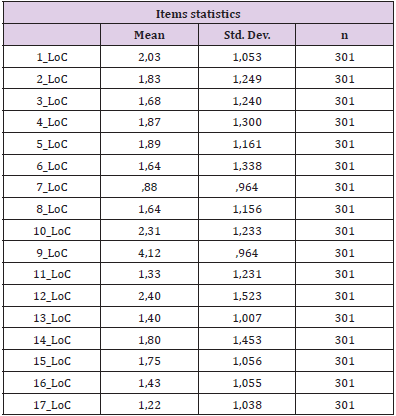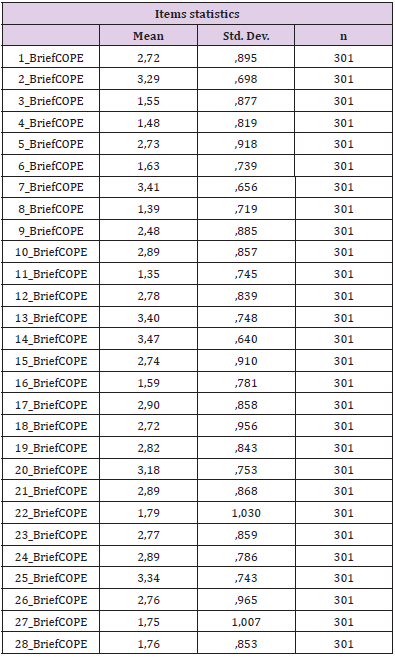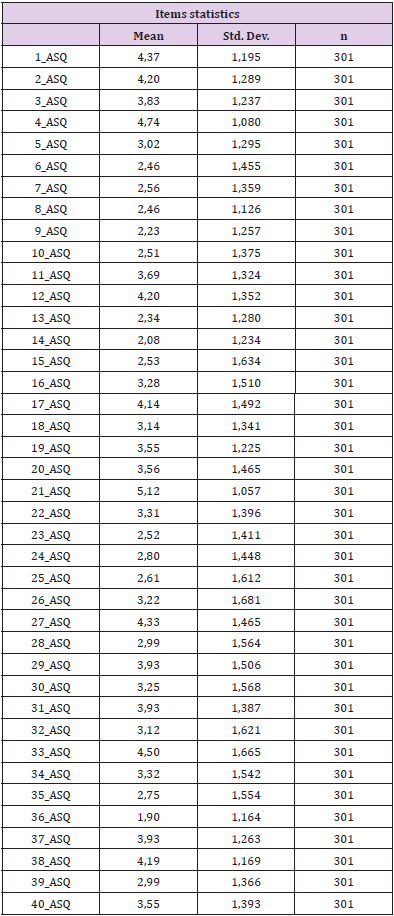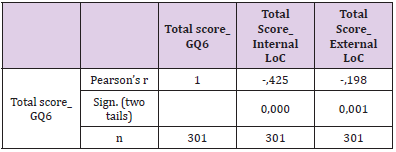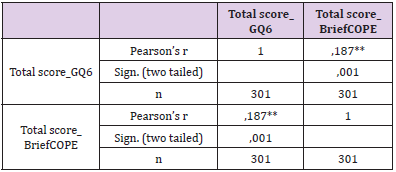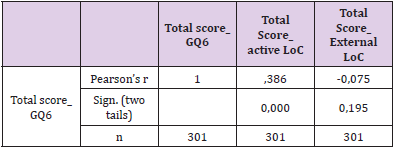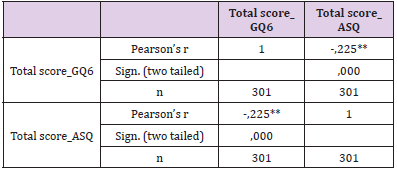ABSTRACT
Objectives: In this exploratory study the objective was to find a relationship between the psychological construct of gratitude and the constructs under exam, that is, the Locus of Control, Coping, individual differences in adult attachment and a broader spectrum of psychopathological symptoms. For the latter construct, a negative correlation with gratitude has been hypothesized.
Methods: 301 subjects were recruited, through a snowball sampling approach, Google Forms was used for the purpose of administering the battery of questionnaires. To measure the independent variable (gratitude), McCullough’s Gratitude Questionnaire (GQ-6) was used (2013), for the dependent variables (LoC, coping, attachment and psychopathological symptoms), respectively, was used: Craig’s, Franklin’s and Andrews’ LCB (1984), Carver’s BriefCOPE (1997), Feeney, Noller and Hanrahan’s ASQ (1994) and Derogatis’s BSCL (1975).
Results: the reliability level of the main scale (GQ-6) is acceptable with a Cronbach’s alpha of 0.72. A significant correlation was found between the total score of the GQ-6 scale and the LCB (r = -36), BriefCOPE (r = 20), ASQ (r = -20), BSCL (r = -30) scales.
Conclusion: Significant correlations were observed between Gratitude and the constructs examined.
Keywords: Gratitude; Locus of Control; Coping; Attachment; Psychopathological Symptoms
Introduction
Many of us express gratitude by saying “thank you” to someone who helped us or gave us a gift. From a scientific standpoint, however, gratitude isn’t just an action: it’s also a positive emotion that serves a biological purpose. Like most words, gratitude appears to have different meanings depending on the context. For example, gratitude has been conceptualized as a moral virtue, attitude, emotion, habit, personality trait, and coping response [1]. Some researchers have defined gratitude as a positive emotional reaction in response to receiving a gift or benefit from someone [2]. Gratitude has also been conceptualized both as a mood phenomenon (that is, an emotional reaction to an event or experience) and as a dispositional feature or a trait phenomenon [2]. For our purposes, we would like to define gratitude in a much broader sense. Gratitude is the appreciation of what is valuable and meaningful to oneself and represents a general state of gratitude or appreciation. This proposed definition transcends the interpersonal nuances attributed to the term (i.e. the construct of receiving something from someone) and allows for a more inclusive meaning (e.g., being grateful for experiences, such as being alive, connecting with nature, and countless others). Positive psychology states that gratitude and its effects can be measured by scientists, thus arguing that gratitude is more than feeling grateful: it is a deeper construct that produces lasting positivity.
The correlation between the Gratitude construct and the Locus of Control was measured, however, no relevant research was found in the literature to compare the results of the relationship measured in this study. Regarding the relationship between Gratitude and Coping, a study by Wood, Joseph and Linley [3] showed that the person’s gratitude is linked to coping styles: in our research we examined the same relationship between constructs. For Nourialeagha, Ajilchi and Kisely [4] gratitude correlates with attachment and our research aims to examine the same relationship. With regard to the last correlation under consideration, it was hypothesized that the construct of Gratitude correlated negatively with the inventory of psychopathological symptoms (BSCL), based on the confirmation of this hypothesis by Southwell [5].
Methodology and Tools
This survey consists of an exploratory study conducted on a sample of Italian citizens.
Sampling Approach
A snowball sampling approach was used. For the purpose of administering the battery of questionnaires, Google Forms was used, an open-source tool for the development and administration of ad hoc online questionnaires / surveys. Due to the sampling procedure used, we were unable to calculate the response rate. There were no missing elements to deal with and, as such, no imputation analysis was required.
The Gratitude Questionnaire (GQ-6)
McCullough’s (2013) The Gratitude Questionnaire (GQ-6) scale was used to measure the independent variable (Gratitude). The six items that make it up are classified on a seven-point Likert scale, ranging from 1 (strongly disagree) to 7 (strongly agree).
Locus of Control of Behavior (LCB)
The Locus of Control of Behavior (LCB) by Craig, Franklin and Andrews [6] was used to measure the first dependent variable (Locus of Control). It is a self-report questionnaire of 17 items with responses on a six-point Likert scale (from completely disagree to completely agree). It measures, in fact, the Locus of Control (internal or external) of the behavior that the subject usually finds himself using in various situations. Some questions underline the role of the subject in controlling situations (internal LoC), while the other group indicates how events are relatively independent from the actions of the subject (external LoC). Differentiate people based on continuous characteristics rather than discrete styles.
Brief Cope
Carver’s Brief COPE [7] was used to measure the second dependent variable (Coping). It is a self-report questionnaire of 28 items with responses on a five-point Likert scale from 0 (never) to 4 (always).
The scale measures two modes of coping:
a) Active Coping: Characterized by the subscales of active coping, positive reformulation, planning, acceptance, seeking emotional support, and seeking information support. The approach to coping with adversity is associated with more active responses to adversity, including practical adaptive adjustments, better physical health outcomes, and a more stable emotional response.
b) Avoidant Coping: characterized by the subscales of denial, substance use, release, behavioral disengagement, selfdistraction, and self-blame. Avoidant coping is associated with poorer physical health among people with medical conditions. Compared to Active Coping, Avenger has been shown to be less effective in managing anxiety.
Attachment Scale Questionnaire (ASQ)
The Attachment Scale Questionnaire (ASQ) by Feeney, Noller and Hanrahan [8] was used to measure the third dependent variable (attachment). It is a self-report questionnaire of 40 items with responses on a six-point Likert scale (from totally disagree -1- to totally agree -6-). It detects the individual differences in the attachment of the adult and is aimed at adolescents and adults who are not necessarily engaged in a couple relationship. The questionnaire differentiates the participants in reference to characteristics of a continuous type, not on the basis of discrete styles. The dimensions that are evaluated are five and constitute as many subscales: Trust, Discomfort with intimacy, Secondary relationships, Need for approval, Concern for relationships.
Brief Symptoms Checklist (BSCL)
The Derogatis [9] Brief Symptoms Checklist (BSCL) was used to measure the fourth variable (psychopathological symptom construct). The scale consists of 53 items on a five-point Likert scale, from 0 (never) to 4 (always). These items cover nine psychopathological dimensions: Somatization, Obsession- Compulsion, Interpersonal Sensitivity, Depression, Anxiety, Hostility, Phobic Anxiety, Paranoid Ideation and Psychoticism; three global indices of distress: global severity index, distress index positive symptom and total positive symptom. Global indices measure the current or past level of symptoms, symptom intensity, and number of symptoms reported.
Statistical Analysis
Once the data was collected, before starting any treatment and processing of these, they were visually inspected to find outliers. The normality of the data distribution was verified on the basis of the size of the sample recruited. Subsequently, some descriptive analyzes were conducted with the aim of providing information on the general characteristics of the study groups in terms of reported scores. Finally, Cronbach’s alpha coefficients were calculated as estimates of the instrument’s internal reliability and consistency. The following rule of thumb was used to interpret the magnitude of the coefficient: it was found to be unacceptable if it was less than 0.5, poor in the 0.5-0.6 range, questionable in the 0.6-0.7 range, acceptable in the range 0.7-0.8, good in the range 0.8-0.9 and, finally, it was considered excellent if greater than 0.9. A correlation analysis was performed between the GQ-6 scores and the LCB, Brief COPE, ASQ, BSCL scales. The size of the Pearson coefficient was interpreted following the rule of thumb developed by Hinkle, et al. [10], the strength of the correlation was considered negligible if the coefficient r ranged from 0.00 to 0.30, low from 0.30 to 0.50, moderate from 0.50 to 0.70, high from 0, 70 to 0.90 and very high from 0.90 to 1.00. All statistical analyzes were conducted using the commercial software “Statistical Package for Social Sciences” (SPSS for Windows, version 26.0, IBM, Armonk, NY, USA).
Studio Esplorativo
The Gratitude Questionnaire [2]: 301 subjects were recruited. The mean scores for each item on The Gratitude Questionnaire (GQ- 6) scale are shown in (Table 1). For the GQ-6, the mean score was 30.40 ± 6 with a minimum score of 14 (the minimum achievable score on the continuum line of the scale is 6) and a maximum of 42 (the maximum achievable score on the continuum of the scale). The values measured in the sample extracted from the population are at medium-high levels. In terms of internal consistency, Cronbach’s alpha was acceptable, producing a value of 0.72 which, based on the conventional cut-off, indicates that the level of reliability and internal consistency of the construct under exam is more than satisfactory (Table 2).
Locus of Control of Behavior [6]:
a) The mean score of the internal Locus of Control score was 11 ± 4.53
b) The mean score of the external Locus of Control was 20.20 ± 6.5
In terms of internal consistency, Cronbach’s alpha was acceptable, producing a value of 0.73 which, based on the conventional cut-off, indicates that the level of reliability and internal consistency of the construct under exam is more than satisfactory (Table 3).
Brief Cope [7]: In the sample under exam, active coping presented an average score of 44.42 ± 5.7, while avoidant coping totalized an average of 34.1 ± 4.9. In terms of internal consistency, Cronbach’s alpha was questionable, yielding a value of 0.62 (Table 4).
Attachment Scale Questionnaire [8]: The scores of the various dimensions were:
a) Confidence: the average score was 32.5 ± 6.1 with reference values 32.25 ± 5.74 it can be observed that the score obtained is within the established average.
b) Discomfort with Intimacy: the average score was 35.5 ± 7.7 with reference values 37.95 ± 7.12 it can be observed that the score obtained is below the established average but not significantly.
c) Secondary Relationships: the average score was 16.2 ± 5.4 with reference values 16.71 ± 5.96 it can be observed that the score obtained is within the established average.
d) Need for approval: the average score was 22.6 ± 6 with reference values 20.82 ± 5.99 it can be observed that the score obtained is above the established average but not significantly.
e) Concern for Relationships: the mean score was 26.3 ± 6.5 with reference values 28.81 ± 6.08 it can be observed that the score obtained is below the established average but not significantly.
In terms of internal consistency, Cronbach’s alpha was acceptable, producing a value of 0.71 which, based on the conventional cut-off, indicates that the level of reliability and internal consistency of the construct under exam is more than satisfactory (Table 5).
Brief Symptoms Checklist [9]: The mean score was 60.7 ± 38.3. The values measured in the sample extracted from the population are on average levels. Scores of 63 and above are considered clinical cases. In our sample, therefore, we can conclude that the average is within the norm. In terms of internal consistency, Cronbach’s alpha was excellent, producing a value of 0.96 which, based on the conventional cut-off, indicates that the level of reliability and internal consistency of the construct under consideration is more than satisfactory (Table 6).
Correlations
Table 7: Pearson’s r correlation between GQ-6 and internal/ external Locus of control measured by LCB.
Correlation Between Gq-6 and LCB: There is a significant (-, 365) relationship between the GQ-6 questionnaire and LCB. Based on the conventional cut-off, it indicates that the correlation strength is low (Table 7). Correlations with external Locus of Control are as follows: The results showed that there is a negative correlation between Gratitude and the Locus of Control construct itself (internal and external), however a more positive correlation emerges between External LoC and Gratitude, which could suggest that those who have achieved higher score in the questionnaire that measures gratitude levels, most likely have a more external Locus of Control (r = -, 198 versus r = -, 425) (Table 8).
Correlation Between Gq-6 and Brief Cope: There is a significant relationship (.187) between the GQ-6 questionnaire and BriefCOPE. Based on the conventional cut-off, it indicates that the strength of the correlation is negligible. Here are the correlations with the various dimensions (Table 9). The results showed that there is a positive correlation between Gratitude and active coping, and a negative correlation between Gratitude and avoidant coping, translated into a practical aspect these results suggest that:
a) Those with the highest levels of gratitude have an active coping style (r = .386).
b) Consistent with the above point, the higher the level of gratitude in a person, the more rarely that person will have an avoidant coping style (r = -, 075) (Table 10).
Table 9: Pearson’s r correlation between GQ-6 and active/ avoidant coping style measured by BriefCOPE.
Correlation Between GQ-6 and ASQ: There is a significant relationship (-, 225) between the GQ-6 questionnaire and the ASQ. Based on the conventional cut-off, it indicates that the strength of the correlation is in any case negligible. Here are the correlations with the various dimensions (Table 11).
Considering the various dimensions present in the ASQ questionnaire, the results showed that:
a) Those who have higher levels of gratitude will likely also have higher levels of confidence in themselves and in interpersonal relationships (r =, 500).
b) Those who have higher levels of gratitude will probably also have a lower discomfort with intimacy, considering that, in fact, the correlation between the constructs is negative (r = -, 260).
c) Those with higher levels of gratitude will likely also have a lower tendency to view social relationships as a minor factor (r = -, 261).
d) Those who have higher levels of gratitude will probably also have a lower need for approval from significant others, this translates into greater autonomy in the person (r = -, 193).
e) Those who have higher levels of gratitude will probably also have a lower sense of apprehension regarding the relationship with the significant other (r = -, 323) (Table 12).
Correlation Between GQ-6 and BSCL
There is a relationship (-, 290) between the GQ-6 questionnaire and BSCL. Based on the conventional cut-off, it indicates that the strength of the correlation is negligible. The findings therefore suggest that those with the highest levels of gratitude are also less likely to develop psychopathological symptoms, such as somatization, obsession and compulsion, interpersonal sensitivity, depression, anxiety, hostility, phobic anxiety, paranoid ideation, and psychoticism.
Discussion
In this study we examined the correlations between different psychological constructs as independent variables in relation to the construct of gratitude. The tests used demonstrated solid and robust psychometric characteristics. The aim of this study was to establish what were the relationships between the Locus of Control, coping, individual differences in adult attachment and, considering the exploratory and preliminary nature of the research, it can be said that the set goal was achieved and the publication of this will provide the basis for further research by the scientific community. Regarding the hypothesis that there was a significant negative correlation between the construct of gratitude and a wider spectrum of psychopathological symptoms measured with the BSCL, as already noted by the scholar Southwell in 2012, it can be said that this result was reiterated in our study, confirming the hypothesis we initially formulated.
Conclusion
Gratitude can be defined as appreciation of what is valuable and meaningful. It represents a general state of appreciation. Tendentially, from the results that emerged, the psychological construct of Gratitude seems to belong to more autonomous and active individuals. Research also indicates that there are a number of potential nuances in the relationship between gratitude and constructs that could possibly be relevant to the effective integration of gratitude techniques into psychotherapeutic treatment. According to some authorities [11-13], the techniques available to increase gratitude are relatively simple and easy to integrate into psychotherapeutic practice, although the characteristics of these techniques in terms of effectiveness and continuous change remain largely unknown. Only future research will clarify the many questions about valuing and raising gratitude.
References
- Lambert NM, Graham SM, Fincham FD (2009) A prototype analysis of gratitude: varieties of gratitude experiences. Pers Soc Psychol Bull 35: 1193-1207.
- Roberts RC (2004) The blessings of gratitude: a conceptual analysis. In: Emmons RA, McCullough ME (Eds.)., The Psychology of Gratitude. New York, Oxford University Press, UK p. 58-78.
- Wood AM, Joseph S, Linley P (2007) Coping Style as a Psychological Resource of Grateful People. Journal of Social and Clinical Psychology - J SOC CLIN PSYCHOL 26(9): 1076-1093.
- Nourialeagha B, Ajilchi B, Kisely S (2020) The mediating role of gratitude in the relationship between attachment styles and psychological well-being. Australasian Psychiatry 28(4): 426-430.
- Southwell (2012) Gratitude: A basis for positive psychology interventions with a clinical population. Submitted in partial fulfillment of the requirements for the award of Master of Psychology (Clinical). School of Psychology.
- Craig A, Franklin JA, Andrews G (1984) A scale to measure locus of control of behavior. British Journal of Medical Psychology 57: 173-180.
- Carver CS (1997) You want to measure coping but your protocol’s too long. Consider the Brief COPE International Journal of Behavioral Medicine 4(1): 92-100.
- Feeney J, Noller P, Mary U Hanrahan (1994) Assessing adult attachment. In MB Sperling, WH Berman. Attachment in adults Clinical and developmental perspectives, pp. 128-152.
- Derogatis LR (1975) Brief Symptom Inventory. Baltimore. Clinical Psychometric Research.
- Hinkle DE, Wiersma W, Jurs SG (2003) Applied statistics for the behavioral sciences (6th )., In: Hinkle DE, Wiersma W, Jurs SG (Eds.)., Boston, Mass: Houghton Mifflin, Ireland.
- Sansone RA, Sansone LA (2010) Gratitude and well-being the benefits of appreciation. Psychiatry 7(11): 18-22.
- Mc Cullough ME (2013) The Gratitude Questionnaire (GQ-6) Measurement Instrument Database for the Social Science.
- AT Beck, Weissman A, Lester D, Trexler L (1974) The measurement of pessimism: the Hopelessness Scale. J Consult Clin Psychol 42(6): 861-865.

 Research Article
Research Article
